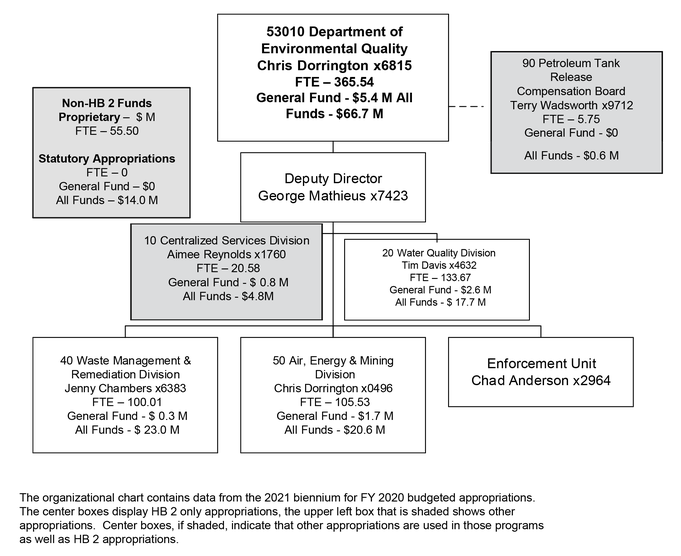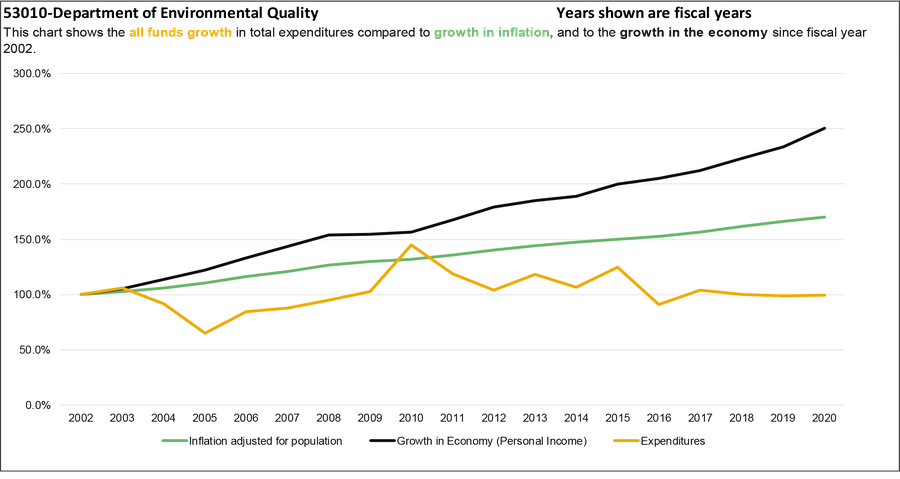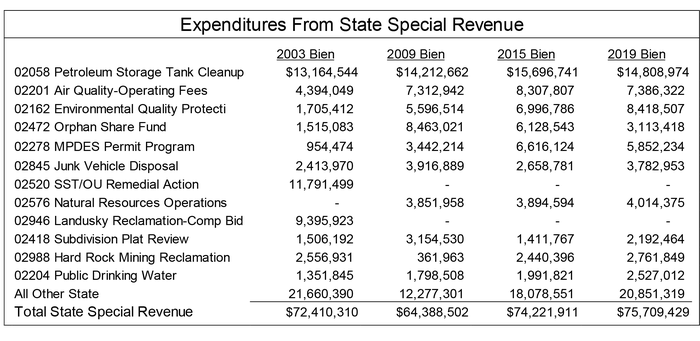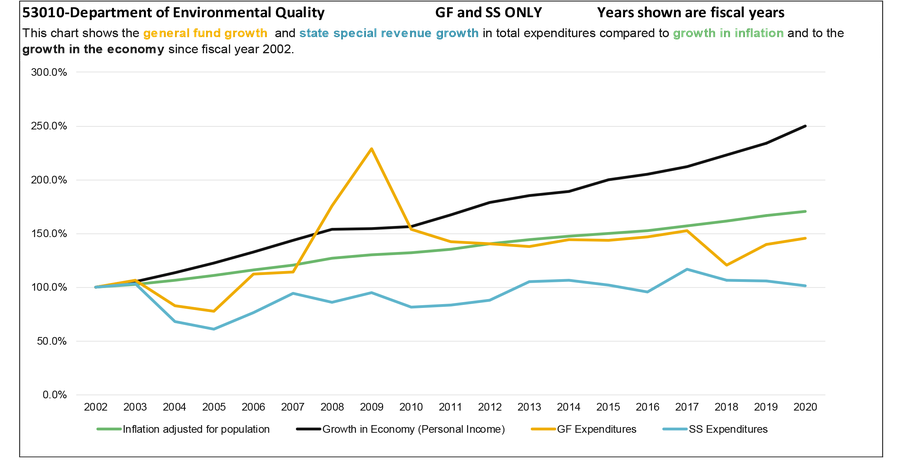Montana State Legislature
Department of Environmental Quality
The Department of Environmental Quality (DEQ) is responsible for regulating air, water, and ground resources to administer Montana’s environmental and mine reclamation laws. DEQ works in partnership with the federal Environmental Protection Agency (EPA), Department of Energy, and Office of Surface Mining, Reclamation, and Enforcement (OSM). EPA and OSM have delegated authority and responsibility for particular environmental areas to DEQ. The EPA state-federal cooperative agreement provides federal resources to DEQ but also directs much of the agency activity.
Five divisions form DEQ and perform the following functions:
- The Central Management Program provides managerial and administrative support services to the entire department
- The Water Quality Division oversees issues of water quality within Montana including permitting, the development of water quality plans, encouraging the use of new practices, and providing assistance
- The Enforcement Division investigates possible violations of Montana environmental laws and monitors compliance
- The Waste Management & Remediation Division manages the waste processing, investigates environmentally contaminated sites, and directs cleans up efforts
- The Air, Energy & Mining Division reviews and assesses permit and license applications impacting air and land environmental quality and provides information on energy production, conservation and renewable opportunities
In addition, although it is not attached to DEQ by law, the Petroleum Tank Release Compensation Board is functionally supported by DEQ. The board provides procedures and resources for reimbursement of expenditures for cleanup of petroleum tank leaks.
Below is an organizational chart of DEQ, including full-time equivalent (FTE) numbers and the HB 2 base general fund appropriations and the total of all funds. Unless otherwise noted, all phone extensions are preceded by (406) 444.


This report includes a series of charts that compare expenditure growth to the growth in the economy and growth in inflation adjusted for population. Montana statute, 17-8-106, MCA, recommends using growth in personal income for comparison purposes. Personal income is a measure for growth in the economy. Comparing growth allows financial planners to consider past and future demands in services or changes in revenues.
HB 2 authority funds 72.3% of total expenditures. The HB 2 base budget has grown from $127.1 million in the 2001 biennium to $133.4 million in the 2021 biennium, an annual growth rate of less than 1.0% compared to a rate of inflation of 2.1% over the same period.
Decreases in expenditures in FY 2005 were due to reduced federal funding for abandoned mines. Increases in funding during FY 2009 through FY 2012 were due to federal funding through the American Recovery and Reinvestment Act.
The following table shows the sources that account for 75% of expenditures from state special revenue accounts. Expenditures from the petroleum tank cleanup fund account for 20% of all expenditures from state sources.


Growth in the base budget is driven by increases in personal services which has more than doubled since the 2001 biennium. Funding of the base budget has shifted from state special revenue to general fund and federal sources. Increases in general fund from FY 2008 through FY 2010 are related to one-time-only appropriations for IT projects and reclamation projects.
Legislative Changes
2015 Session
- SB 96 expanded possible uses for the Orphan Share fund to allow for more proactive action on the part of the Department of Environmental Quality.
2009 Session
- HB 645 provided one-time federal spending authority for $23.9 million for the state energy building program, approximately $20 million for wastewater and drinking water infrastructure improvements through the State Revolving Fund, $7.6 million in energy efficiency grants for local governments, and other miscellaneous funding for public works projects associated with federal recovery act projects.
2007 Session
- HB 116 revised the distribution of resource indemnity trust interest and resource indemnity groundwater assessments, clarified use of resource indemnity related funds, and prioritized expenditures to on-the-ground projects. This legislation impacts the department through increases in revenues to the orphan share and the environmental quality protection fund.
Click the double-sided arrow in the lower right corner of the image below to enlarge the graphic. Then, click the box next to the agency you want to see. To minimize, click Esc.
Legislative Studies
Environmental Quality Council interim work
Audit Reports
Performance Audit - Water Pollutant Discharge Permitting and Inspecting Processes - Sept 2018
Financial Compliance Audit - DEQ - Nov 2018
Legislation
See the Legislation tab on the Environmental Quality Council interim committee web page
HB 268, Revise laws related to maintenance district assessments
HB 271, Revise county road adoption procedure re: subdivision plots
HB 273, Eliminate restrictions on nuclear facility development
SJ 3, Provide for a feasibility study of advanced nuclear reactors
SB 161, Allow certain subdivisions to qualify for an expedited review
SB 164, Revise non-degradation standard for nitrates
SB 165, Generally revise laws related to the department of environmental quality
SB 180, Establish an interim committee on soil health
SB 328, Revise coal bonding laws
HB 599, Revise opencut laws
HB 419, Generally revise laws to create Superfund oversight committees
HB 444, Revise subdivisions of land exempted from sanitation in subdivision review
HB 475, Revise renewable portfolio standard to include hydropower
HB 481, Protect critical infrastructure
SB 284, Revise county gravel pit permitting
Gov. Gianforte 2023 Biennium Budget - Department of Environmental Quality
2023 Biennium Executive Summary - Department of Environmental Quality
Agency profile information provided by the Legislative Fiscal Division.
